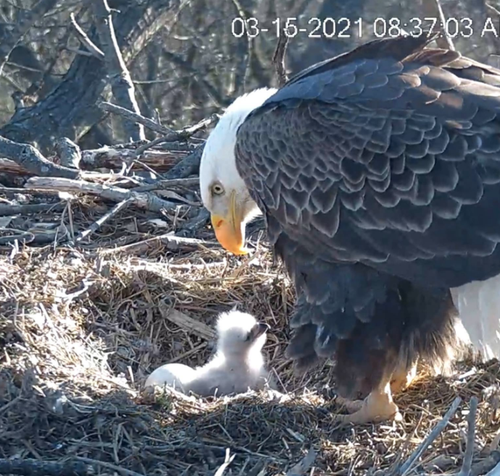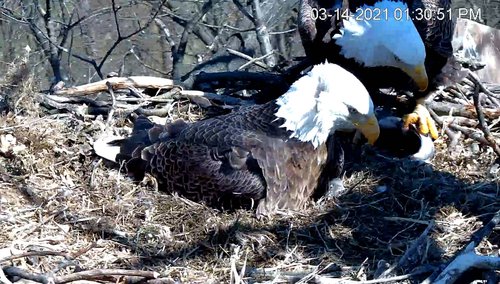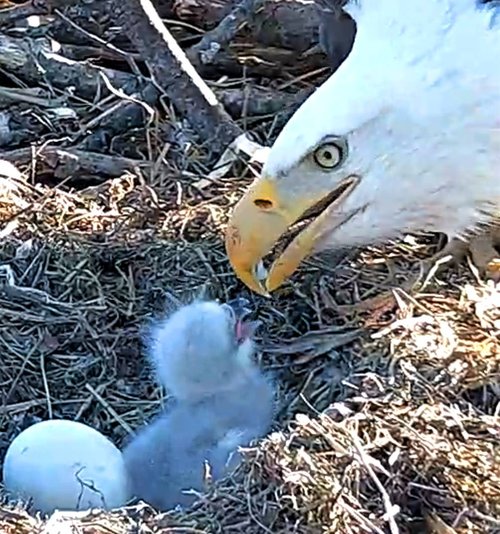Hanover Bald Eagle Blog # 11 - 2021
In partnership with Pennsylvania Game Commission and Comcast Business .

The first Hanover hatchling finally arrived on Saturday March 13th at roughly 6 in the morning! This objectively adorable fluff ball is officially the third member of this year’s Hanover family, and its sibling is likely preparing to emerge as we speak. Bald eagle eggs typically hatch 2-3 days apart, mirroring the same time interval of when they were laid. The first hatchling will weigh more than the second, as is typical for raptor young.
At this point, the female will be present at the nest about 90% of the time, and the male 50%, with someone being present pretty much around the clock. This is important, because eagle hatchlings cannot thermoregulate until they are fifteen days old when their second layer of down feathers comes in. Meanwhile, the Hanover parents must keep the hatchling warm.

In bird world, there are two types of young: Altricial (from the Latin root meaning “to nourish,” and precocial (from the same Latin root as the word “precocious”). The latter refers to hatchlings that can thermoregulate for themselves, open their eyes, sit up, and leave the nest after a few days. Think ducks. Or Brush Turkeys, an Australian species that takes the concept of precocious to a whole new level: The eggs are laid in piles of decaying plant matter, and when they hatch, the chicks dig themselves out and fly away!
Altricial young are on the other end of the spectrum. They hatch with eyes closed, limited mobility, and remain dependent on parental care for an extended period of time. Bald eagle hatchlings, like most raptors, are “semi-altricial.”

Why do raptors hatch relatively helpless? It’s all about tradeoffs. True, altricial young require a lot more attention from their parents, but raising precocial young isn’t a walk in the park either parents of precocial young must put energy into producing more energetically rich and nutritious eggs so that the embryo can develop more fully while still inside the egg. Both of these strategies, altricial and precocial, require different types of parental investment.
The strategy of having precocial young is thought to have evolved first, yet today more than 80% of birds produce altricial young, implying that the strategy has become the better fit for a majority of species. Environmental pressures play a role in determining which reproductive strategy a species uses.
Raising altricial young has been called the “individual care” strategy by researchers, while precocial has been deemed the “mass production” strategy. Again, think ducks: Mom paddling across the pond with a brigade of ducklings kicking vigorously behind her. Species that raise precocial young typically lay larger clutches as a form of insurance. Since they leave the nest soon after hatching, ducklings are vulnerable to predators (a pressure) for a relatively longer period of time. Therefore, it’s worth it for the female to lay many eggs in case something happens to some of the chicks. Species like the bald eagle lay small clutches, and spend a lot of energy and time making sure nobody gets eaten. Therefore, each individual hatchling has an arguably higher chance of surviving into adulthood.
Another environmental pressure to consider is food availability. For many bird species, there is a strong correlation between when food becomes available, and reproductive strategy. Raising precocial young is common for species that eat plants, because plants are more consistently present than say, mice or insects, which are available for a more finite period of time and require hunting skills, which take time to learn. Bald eagles, for example, need to learn how to scavenge and catch fish, whereas ducks are born ready to forage for plants.
In the coming weeks, keep an eye out for the rapid growth and increased locomotion of the first hatchling, and in the coming days, get ready to welcome another fluffy youngster into the world!
Fun Fact: The parents will feed the hatchling anywhere between 1-8 times per day, gently offering one small piece of meat at a time.
Sources
Ehrlich, David S. et al. “Precocial and Altricial Young.” stanford.edu. 1988.
https://web.stanford.edu/group/stanfordbirds/text/essays/Precocial_and_Altricial.html. Accessed 13 Mar. 2021
ATTENTION HANOVER EAGLE VIEWERS - We recognize that over the years this bald eagle pair has been named by the public and is commonly referred to as "Freedom" and "Liberty". While we understand that naming the eagles helps connect and distinguish the female from the male eagle, naming the pair introduces an element of domesticity to wild animals. In order to respect the eagles and focus on their natural history, we will refer to the female and male as such as per recommendations of the Pennsylvania Game Commission.

RAPTOR ECOLOGY SPECIALIST - ZOEY GREENBERG
RETURN TO HANOVER BALD EAGLE BLOGS
WATCH THE HANOVER BALD EAGLE LIVE CAMS
For over 20 years, HDOnTap has provided live streaming solutions to resorts, amusement parks, wildlife refuges and more. In addition to maintaining a network of over 400 live webcams, HDOnTap specializes in design and installation of remote, off-grid and otherwise challenging live streaming solutions. Contact press@hdontap.com for all media needs, including images and recordings.